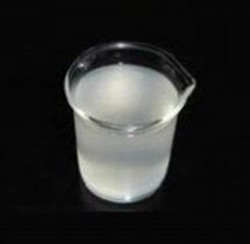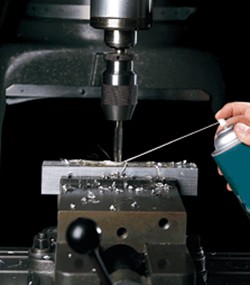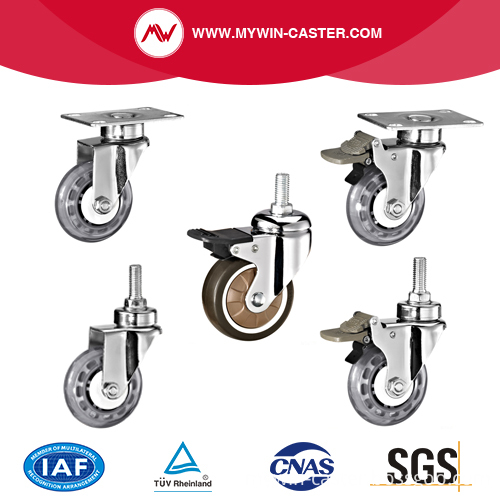The chemical added to improve the performance of the cutting fluid is called an additive. Common oil and extreme pressure additives, anti-rust additives, anti-mold additives, anti-foam additives and emulsifiers, etc.
1. Oily additives and extreme pressure additives
The oily additive is mainly applied to the low-pressure low-temperature boundary lubrication state. It mainly acts as an infiltration and lubrication during the metal cutting process, reducing the interfacial tension between the oil and the metal, so that the cutting oil quickly penetrates into the cutting zone and further under a certain cutting temperature. A physical adsorption film is formed to reduce the friction between the rake face and the chips, the flank face and the workpiece.

In extreme pressure lubrication, extreme pressure additives must be added to the cutting fluid to maintain the strength of the lubricating film. Commonly used extreme pressure additives are organic compounds containing sulfur, phosphorus, chlorine, iodine, etc. These compounds chemically react with the metal surface at a high temperature to form a chemical adsorption film, which is much higher than the melting point of the physical adsorption film and can prevent the pole. The metal friction interface is directly contacted under pressure lubrication to reduce friction and maintain lubrication. Common extreme pressure additives are as follows:
(1) Extreme pressure additive containing sulfur : There are two ways to introduce sulfur into the cutting fluid. One is mineral oil directly vulcanized with elemental sulfur, called sulfurized cutting oil; the other is added sulfur-containing additive to mineral oil. Such as sulfurized animal and vegetable oils, sulfurized olefins and sulfur, chlorinated animal and vegetable oils, etc., to make extreme pressure cutting oil. Vulcanized cutting oil has a corrosive effect on copper and copper alloys, and has a large odor during processing, and has been gradually replaced by extreme pressure cutting oil. Sulfur-containing extreme pressure cutting oil chemically reacts with metals during metal cutting to form iron sulfide. Iron sulfide does not have a layered structure like ferric chloride, which has a higher friction coefficient than ferric chloride, but has a high melting point (melting point of iron sulfide is 1193 ° C, melting point of iron disulfide is 117 l ° C), and vulcanized film is not easily broken at high temperature, so cutting steel When it is used, it can maintain its lubricating performance at a high temperature of about 1000 °C.
(2) Extreme pressure additives containing chlorine: Commonly used chlorine-containing extreme pressure additives are chlorinated paraffins (chlorine content 40% - 50%), chlorinated fatty acids or esters. The chemical properties of chlorine are active and can react chemically with metal surfaces at 200-300 °C. The friction coefficient of chloride is lower than that of sulfide, so the chlorine extreme pressure additive has excellent lubricating properties. The cutting fluid containing chlorine extreme pressure additive can withstand high temperature of 600 °C, especially suitable for cutting alloy steel, high strength steel and molybdenum. And other difficult to cut materials. Chlorinated paraffin and the like are corrosive and must be used together with oil-soluble rust preventive additives. Some sources [30] believe that the focus of chlorine-containing additives should be on highly volatile additives such as carbon tetrachloride, because it can penetrate into the micro-cracks between the chip, the workpiece and the tool interface, while preventing cold welding. Wear occurs. However, since carbon tetrachloride volatilizes harmful gases, it is rarely used in China.
(3) Extreme pressure additive containing phosphorus : In the cutting fluid, the commonly used phosphorus-containing additive is an organic phosphate or zinc thiophosphate. These additives have moderate extreme pressure properties. They are adsorbed in contact with steel and react chemically to form a chemical lubricating film of iron phosphate. The effect of reducing friction and reducing wear is better than that of sulfur-containing and chlorine-containing extreme pressure additives. .
In order to obtain a better cutting fluid, the above two or three kinds of additives are often added to a cutting fluid, and are used in combination, so that the cutting fluid quickly enters the high temperature cutting zone to form a strong chemical lubricating film.
Second, anti-rust additives
In order to protect the machine tool, tool and workpiece from corrosion, add anti-rust additives to the cutting fluid. It is a very polar compound with strong adhesion to the metal surface. It preferentially adsorbs on the metal surface to form a protective film, or combines with the metal surface to form a passivation film to protect the metal surface from contact with corrosive media. Therefore, it plays a role of rust prevention. Commonly used anti-rust additives can be divided into two categories: water-soluble and oil-soluble:
(1) Water-soluble anti-rust additive: There are many varieties of water-soluble anti-rust additives, among which sodium nitrite is widely used in emulsions and aqueous solutions. Sodium nitrite has substantially no lubricating properties, and has an anti-rust effect on steel in an alkaline medium. The amount is generally controlled at about 0.25%, and the higher concentration is harmful to the operator's skin. The anti-rust effect of sodium nitrite is ineffective or even corrosive to non-ferrous metals (such as copper, aluminum and its alloys). For the emulsion or aqueous solution of copper, it is advisable to use benzotriazole as an anti-rust additive. Adding 0.01%-0.1% means seeing the effect. It should be noted that when the water-soluble anti-rust additive is used in the emulsion, the amount should not be too large, because most of them are electrolytes, and the amount of the emulsion is excessively destroyed, so that the oil and water are separated.
(2) Oil-soluble anti-rust additive: The oil-soluble anti-rust additive is mainly used for anti-rust emulsion, and also for cutting oil. In the course of use, various rust inhibitors with different characteristics are often used in combination to achieve a good effect of comprehensive rust prevention. Such as the addition of oxidized petroleum esters and soaps, can improve the atmospheric corrosion resistance; the addition of amines, can improve the antioxidant properties of oils, neutralize acidic substances, add lanolin and its soaps, can improve the adsorption.
Third, anti-mold additives
After long-term use of the emulsion, it is easy to deteriorate and smell, which is the result of bacterial growth. As long as you add a few tenths of anti-mildew additives, you can kill and inhibit the growth of bacteria. However, the anti-mold additive may cause erythema, itching, etc. on the operator's skin, so it is generally not used.
Fourth, anti-foam additives

Surfactants such as rust inhibitors and emulsifiers are generally added to the cutting fluid, which increase the possibility of mixing into the air to form a foam. If there is too much foam, it will reduce the effect of the cutting fluid. If a few parts per million anti-foam additive (such as dimethicone) is added, foam formation can be effectively prevented. In the case of high-speed and powerful grinding, since a relatively large amount of foam is generated, it is necessary to add an appropriate amount of anti-foaming agent to the grinding fluid and perform a defoaming test.
Five, emulsifier

Emulsion is a key substance that emulsifies mineral oil and water to form a stable emulsion. It can adsorb on the oil-water interface to form a strong adsorption film, so that the oil is evenly dispersed in water to form a stable emulsion.
(1) Mechanism of formation of emulsion (activator of surfactant): Oil and water are originally incompatible with each other, and a dispersion can be formed by high-speed stirring, but will be separated shortly after standing. If a surfactant is added and then stirred and mixed, the oil will be dispersed in water as tiny particles to form a stable emulsion, which is difficult to separate even when left to stand. This is because the surfactant is an organic compound whose molecule is composed of two parts, a polar group and a non-polar group. Polar genes are hydrophilic, called hydrophilic groups, soluble in water; non-polar groups are lipophilic, called lipophilic groups or hydrophobic, soluble in oil.
The surfactant added to the oil and water can be aligned and adsorbed on the oil-water two-phase interface, the polar end faces the water, the non-polar end faces the oil, and the oil and water are connected to reduce the oil-water interfacial tension, so that the oil The particles are stably dispersed in water to form a stable oil-in-water (0/W) emulsion. At this time, water is a continuous phase called a dispersion medium or an external phase; oil is a discontinuous phase called a dispersed phase or an internal phase. The opposite is the water-in-oil (W/O) emulsion. An oil-in-water (O/W) emulsion is used in metal cutting.
In the emulsion, in addition to the emulsification, the surfactant can also adsorb on the metal surface to form a lubricating film, which acts as a lubricating agent for lubrication.
(2) Types of surfactants: There are many types and grades of surfactants, but according to their properties and molecular structure, they can be roughly classified into four types: anionic, cationic, zwitterionic and nonionic. When formulating emulsions, the most widely used are anionic and nonionic surfactants (see Table 8-2 for details).
Anionic surfactants are characterized by good emulsifying properties, certain cleaning and lubricating properties, and some have a certain anti-rust property, but have poor resistance to hard water and are easy to foam.
Nonionic surfactants do not produce ions in emulsions and aqueous solutions, so they are not afraid of hard water and are not limited by pH (the size of the pH), and the hydrophilic and lipophilic groups in the molecule can be adjusted as needed. .
(3) Emulsification stabilizer: The effect of adding stabilizer to the emulsion has two aspects: one is to make the soap in the emulsified oil fully soluble with other additives by the solubilization of the stabilizer to improve the emulsified oil and the emulsion. Stability; the second is to expand the emulsification range of surfactants and improve stability. However, when using an emulsion stabilizer low molecular weight alcohol, special attention should be paid to it because it is also a demulsifier, such as an excessive amount of oil to cause a moisture layer.
Nurses use the medical trolleys to transfer the pills and liquid medicine to patients, medical trolley caster wheels make the medical trolley moving. The medical caster wheels are widely used in many medical trolleys and other medical equipment. MYWIN could provide the plate & threaded mounting type for your choice. Including plate swivel, plate swivel with brake, threaded swivel, threaded swivel with brake.
The material of medical trolley caster we normally use is PU, transparent PU and so on. PU material has the characters like rotary quietness, anti-abrasion, corrosion resistance, which are very suitable for hospital environmental. One important thing need to remind you is that, please do not use the casters while exceed their maximum load capacity, accident is always caused by overload.
As the quality, our casters have the certification proof and have received testing after production. The regular salt and spray test and load capacity test are taken in our every caster. We also have the SGS, IAF, TUV and CNAS certification to make our customers more confident about our products.

Medical Trolley Casters
Medical Trolley Casters, PU Medical Caster, Light Duty Medical Caster, Braked Medical Caster
Ningbo Mywin Caster Co., Ltd. , https://www.mywin-caster.com



